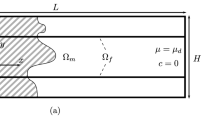Abstract
Simulations from a numerical implementation of the phase-field model for brittle fracture are compared against analytical and experimental results in order to explore the verification and validation of the method. It is found that while the intrinsic length scale associated with the phase-field model can be set arbitrarily, the scale of the fracture process zone, and the scale at which the elastic field attains the corresponding analytical brittle fracture limit could be substantially larger than this intrinsic length. It is demonstrated that with a suitable choice of this length scale, phase-field simulations can provide valid predictions of the growth of cracks in quasi-static brittle fracture.





















Similar content being viewed by others
Notes
There was a minor typographical error in the formula for \(K_I (a)\) in Rubinstein (1985).
Curving vs kinking: The crack paths shown in Fig. 17a are all smooth curves; when the crack was far from the hole, mode II loading increases gradually from zero as the crack approaches the vicinity of the hole. In contrast, if the hole was drilled close to the initial crack, the loading generated a finite jump in mode II loading, and hence the crack initiated with a kink relative to the initial crack. Here, we have only analyzed those experiments that involved a smooth curving of the crack.
References
Ambati M, Gerasimov T, De Lorenzis L (2015) A review on phase-field models of brittle fracture and a new fast hybrid formulation. Comput Mech 55:383–405
Ambrosio L, Tortorelli VM (1990) Approximation of functionals depending on jumps by elliptic functionals via \(\Gamma \)-convergence. Commun Pure Appl Math 43(8):999–1036
Ambrosio L, Tortorelli VM (1992) On the approximation of free discontinuity problems. Boll Un Mat Ital B (7) 6(1):105–123
Amor H, Marigo JJ, Maurini C (2009) Regularized formulation of the variational brittle fracture with unilateral contact: numerical experiments. J Mech Phys Solids 57:1209–1229
Balay S et al (2014) PETSc users manual. ANL-95/11—Revision 3.5. Argonne National Laboratory, Chicago
Borden MJ et al (2012) A phase-field description of dynamic brittle fracture. Comput Methods Appl Mech Eng 217:77–95
Bourdin B (1999) Image segmentation with a finite element method. M2AN Math Model Numer Anal 33(2):229–244
Bourdin B, Francfort GA, Marigo JJ (2000) Numerical experiments in revisited brittle fracture. J Mech Phys Solids 48(4):797–826
Bourdin B, Francfort GA, Marigo J (2008) The variational approach to fracture. J Elast 91:5–148
Braides A (1998) Approximation of free-discontinuity problems. Number 1694 in Lecture Notes in Mathematics. Springer, Berlin
Chambolle A (2004) An approximation result for special functions with bounded variations. J Math Pure Appl 83:929–954 2004
Chambolle A (2005) Addendum to an approximation result for special functions with bounded deformation [J Math Pure Appl (9) 83 (7) (2004) 929–954]: the n-dimensional case. J Math Pure Appl 84:137–145
Erdogan F, Sih GC (1963) On the crack extension in plates under plane loading and transverse shear. J Basic Eng 85:519–525
Giacomini A (2005) Ambrosio–Tortorelli approximation of quasi-static evolution of brittle fractures. Calc Var Partial Differ Equ 22(2):129–172
Goldstein RV, Salganik RL (1974) Brittle fracture of solids with arbitrary cracks. Int J Fract 10:507–523
Karma A, Kessler DA, Levine H (2001) Phase-field model of mode III dynamic fracture. Phys Rev Lett 87:045501
Karypis G, Kumar V (1999) A fast and high quality multilevel scheme for partitioning irregular graphs. SIAM J Sci Comput 20:359–392
Leblond JB (1999) Crack paths in three-dimensional elastic solids. I: two-term expansion of the stress intensity factors-application to crack path stability in hydraulic fracturing. Int J Solids Struct 36:79–103
Miehe C, Hofacker M, Welschinger F (2010) A phase field model for rate-independent crack propagation: Robust algorithmic implementation based on operator splits. Comput Methods Appl Mech Eng 199:2765–2778
Murakami Y et al (1987) Stress intensity factors handbook, vol 1. Pergamon Press, New York
Ortiz M (1985) A constitutive theory for the inelastic behavior of concrete. Mech Mater 4:67–93
Pham K, Amor H, Marigo JJ, Maurini C (2011) Gradient damage models and their use to approximate brittle fracture. Int J Damage Mech 20(4, SI):618–652
Pham K, Marigo JJ, Maurini C (2011) The issues of the uniqueness and the stability of the homogeneous response in uniaxial tests with gradient damage models. J Mech Phys Solids 59(6):1163–1190
Rubinstein AA (1985) Macrocrack interaction with semi-infinite microcrack array. Int J Fract 27:113–119
Acknowledgements
Parts of this work were performed during the course of an investigation into failure under a related research program funded by the Army Research Office (Grant Number: W911NF-13-1-0220). The computations performed as part of this work were supported by a generous allocation of time by the Texas Advanced Computing Center. The authors gratefully acknowledge this support.
Author information
Authors and Affiliations
Corresponding author
Rights and permissions
About this article
Cite this article
Pham, K.H., Ravi-Chandar, K. & Landis, C.M. Experimental validation of a phase-field model for fracture. Int J Fract 205, 83–101 (2017). https://doi.org/10.1007/s10704-017-0185-3
Received:
Accepted:
Published:
Issue Date:
DOI: https://doi.org/10.1007/s10704-017-0185-3




